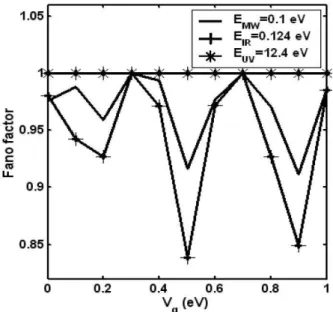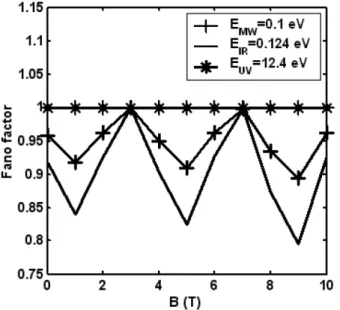January, 2011 PROGRESS IN PHYSICS Volume 1
Noise and Fano-factor Control in AC-Driven Aharonov-Casher Ring
Walid A. Zein∗, Nabil A. Ibrahim†, and Adel H. Phillips∗ ∗Faculty of Engineering, Ain-Shams University, Cairo, Egypt
†Higher Technological Institute, Ramadan Tenth City, Egypt
E-mail: adel phillips@yahoo.com
The spin dependent current and Fano factor of Aharonov-Casher semiconducting ring is investigated under the effect of microwave, infrared, ultraviolet radiation and magnetic field. Both the average current and the transport noise (Fano factor) characteristics are expressed in terms of the tunneling probability for the respective scattering channels. For spin transport induced by microwave and infrared radiation, a random oscillatory behavior of the Fano factor is observed. These oscillations are due to constructive and destructive spin interference effects. While for the case of ultraviolet radiation, the Fano factor becomes constant. This is due to that the oscillations has been washed out by phase averaging (i.e. ensemble dephasing) over the spin transport channels. The present investigation is very important for quantum computing and information processing.
1 Introduction
The field of spintronics is devoted to create, store, manipu-late at a given location, and transport coherent electron spin states through dilute magnetic semiconductors and conven-tional semiconductor heterostructure [1]. The two principle challenges for new generation of spintronics devices are ef-ficient injection of spins into various semiconductor nano-structures and coherent control of spin. In particular, preserv-ing spin coherence, which enables coherent superpositions of states a|↑i+b|↓i and corresponding quantum-interference effects, is essential for both quantum computing with spin-based qubits [2, 3]. The electrical control of spin via Rashba spin-orbit coupling [4], which arises due to inversion asym-metry of the confining electric potential for tow-dimensional electron gas (2DEG), is very important physical parameter when dealing with semiconductor spintronics. The pursuit of fundamental spin interference effects, as well as spin transis-tors with unpolarized charge currents [3, 5–10] has generated considerable interest to demonstrate the Aharonov-Casher effect via transport experiments in spin-orbit coupled semi-conductor nanostructures [7, 11].
The ballistic spin-resolved shot noise and consequently Fano factor in Aharonov-Casher semiconducting ring is in-vestigated in the present paper. The effects of both electro-magnetic field of wide range of frequencies and electro-magnetic field are taken into consideration.
2 Theoretical Formulation
It is well known that shot noise and consequently Fano factor is a powerful quantity to give information about controlling decoherence of spin dependent phenomena [12, 13]. So we shall deduce an expression for both shot noise and Fano fac-tor for spintronic device considered in the paper [10]. This device is modeled as follows: Aharonov-Casher interferome-ter ring in which a semiconductor quantum dot is embedded
Fig. 1: The variation of Fano factor with gate voltage at different photon energies.
in one arm of the ring. The form of the confining potential is modulated by an external gate electrode allowing for direct control of the electron spin-orbit coupling. The effect of elec-tromagnetic field of wide range of frequencies (microwave, infrared, ultraviolet) is taken into consideration.
The spin dependent shot noise Sσσ′ αβ (t−t
′) is expressed
in terms of the spin resolved currentsI(↑), andI(↓) due to the flow of spin-up↑and spin-down↓electrons through the terminals of the present device [14] as
Sσσαβ′ t−t′= 1
2
D
δIˆασ(t)δIˆσ ′ β t
′+δIˆσ′ β t
′δIˆσ α(t)
E (1)
where ˆIσ
α(t) is the quantum mechanical operator of the spin
resolved (σ ⇒↑,↓) current in left leadα, ˆIσ′ β (t
′) is the same
Volume 1 PROGRESS IN PHYSICS January, 2011
Fig. 2: The variation of Fano factor with magnetic field at different photon energies.
definition of ˆIσ
α(t), but for the right lead β. In Eq. (1), the
parameterδIˆσ
α (t) represents the current fluctuation operator
at timetin the left leadαwith spin stateσ(up or down) and is given by
δIˆσα(t)=Iˆασ(t)−DIˆσα(t)E (2)
whereh−−idenotes an ensemble average. The Fourier trans-form of Eq.(1), which represents the spin resolved noise po-wer between the left and right terminals of the device, is given by
Sσσαβ′(ω)=2
Z
d t−t′e−iω(t−t′)
Sαβσσ′ t−t′
. (3)
Since the total spin dependent current is given by
Iα=Iα↑+Iα↓, (4)
the corresponding noise power is expressed as
Sαβ(ω)=S↑↑αβ(ω)+S↓↓αβ(ω)+S↑↓αβ(ω)+Sαβ↓↑(ω) . (5)
Now, expressing the spin-resolved current ˆIασ(t) in terms of the creation and annihilation operators of the incoming elec-trons ˆaσα+(E), aˆσα(E′) and for the outgoing electrons
ˆ
bσα+(E+n~ω), ˆbσα(E′+n~ω) [15], as follows:
ˆ
Iασ(t)= e h
X
n Z Z
dEdE′ei(E−E′)t/~×
h
ˆ
aσα+(E) ˆa σ
α E′−bˆ σ+
α (E+n~ω) ˆb σ
α E′+n~ω i
. (6)
Now, in order to evaluate the shot noise spectrumSαβ(ω)
this can be achieved by substituting Eq.(6) into Eq.(1), and us-ing the transmission eigenfunctions [10] through the present spintronic device, we can determine the expectation value
Fig. 3: The variation of Fano factor with frequencyωS ocat different
photon energies.
[15, 16]. We get an expression for the shot noise spectrum
Sαβ(ω) as follows:
Sαβ(ω)=
2eP0
h X
σ
∞
Z
0
dE
Γµ with photon(E)
2
×
fαFD(E)× h
1−fβFD(E+n~ω) i
(7)
where
Γµ with photon(E)
2
is the tunneling probability induced by the external photons, andfαFD(E),fβFD(E+n~ω) are the
Fermi distribution functions, andP0 is the Poissonian shot
noise spectrum [15].
The tunneling probability
Γµ with photon(E)
2
has been de-termined previously by the authors [10]
The Fano factor, F, of such mesoscopic device is given by [17]:
F= Sαβ(ω)
2eI . (8)
The explicit expression for the Fano factor, F, can be written as, after some algebraic computation of Eqs.(7, 8), [18, 19]:
F= "
P n
P µ
Γµ with photon(E)
2
1−
Γµ with photon(E)
2#
P n
P µ
Γµ with photon(E)
2 . (9)
3 Results and Discussion
The Fano factorFEq.(9) has been computed numerically as a function of the gate voltageVgmagnetic fieldBand func-tion of the frequencyωS ocdue to spin-orbit coupling. These
calculations are performed over a wide range of frequencies
January, 2011 PROGRESS IN PHYSICS Volume 1
of the induced electromagnetic field (microwave, MW, in-frared, IR, and ultraviolet, UV). We use the semiconductor heterostructures asInGaAs/InAlAsas in the paper [10]. The main features of the present obtained results are:
(1) Fig.1, shows the dependence of Fano factor on the gate voltageVg at photon energies for microwave, infrared,
and ultraviolet. As shown from the figure that, the Fano fac-tor fluctuates between maximum and minimum values for the two cases microwave and infrared irradiation. While for the case of ultraviolet irradiation, the Fano factor is constant and approximately equals∼1.
(2) Fig.2, shows the dependence of Fano factor on the magnetic fieldBat photon energies for microwave, infrared, and ultraviolet. The trend of this dependence is similar in a quite fair to the trend and behavior of Fig.1.
(3) Fig.3, shows the dependence of Fano factor on the fre-quencyωS oc associated with the spin-orbit coupling at
pho-ton energies for microwave, infrared, and ultraviolet. An os-cillatory behavior for this dependence for the two cases mi-crowave and infrared are shown. While for the case of ultra-violet, the Fano factor is constant and approximately equals
∼1 as in Figs. 1, 2.
These results might be explained as follows: Computa-tions show that the average current suppression is accompa-nied by a noise maxima and remarkably low minima (Fano factor). These cases are achieved when the electron spin transport is influenced by both microwave and infrared pho-tons. Such results have been observed previously by the au-thors [20–22]. The random oscillatory behavior of the Fano factor can be understood as the strength of the spin-orbit cou-pling is modified by the gate electrode covering the Aha-ronov-Casher ring to tune constructive and destructive spin interference effect [10]. For the case of the induced ultravi-olet radiation, the results show that the Fano factor becomes approximately constant. These results have been observed previously by the authors [23,24]. The constancy of Fano fac-tor might be due to washing out of the oscillations by phase averaging (i.e. ensemble dephasing) over the spin transport channels [23, 24].
We conclude that these phenomena can be used to devise novel spintronic devices with a priori controllable noise lev-els. The present investigation is very important for quantum computing and quantum information processing.
Submitted on September 9, 2010/Accepted on September 14, 2010
References
1. Zutic I., Fabian J., Das Sarma S. Spintronics: Fundamentals and Appli-cations.Review of Modern Physics, 2004, v. 76, 323–410.
2. Nikolic B. K., Zarbo L. P., Souma S. Imaging Mesoscopic Spin Hall Flow: Spatial Distribution of Local Spin Currents and Spin Densities in and out of Multiterminal Spin-Orbit Coupled Semiconductor Nanos-tructures.Physical Review B, 2006, v. 73, 075303.
3. Fabian J., Matos-Abiaguea A., Ertlera C., Stano P., Zutic I. Semicon-ductor Spintronics.Acta Physica Slovaca, 2007, v. 57, 565–907.
4. Rashba E. I. Electron Spin Operation by Electric Fields: Spin Dynamics and Spin Injection.Physica E, 2004, v. 20, 189–195.
5. Nitta J., Meijer F. E., Takayanagi H. Spin Interference Device.Applied Physics Letters, 1999, v. 75, 695–697.
6. Nitta J., Bergsten T. Time Reversal Aharonov-Casher Effect Using Rashba Spin-Orbit Interaction.New Journal of Physics, 2007, v.9, 341– 352.
7. Frustaglia D., Richter K. Spin Interference Effects in Ring Conductors Subject to Rashba Coupling.Physical Review B, 2004, v.69, 235310.
8. Zein W. A., Phillips A. H., Omar O. A. Quantum Spin Transport in Mesoscopic Interferometer.Progress in Physics, 2007, v. 4, 18–21.
9. Zein W. A., Phillips A. H., Omar O. A. Spin Coherent Transport in Mesoscopic Interference Device.NANO, 2007, v. 2, no. 6, 389–392.
10. Zein W. A., Ibrahim N. A., Phillips A. H. Spin Dependent Transport through Aharonov-Casher Ring Irradiated by an Electromagnetic Field.
Progress in Physics, 2010, v. 4, 78–81.
11. Konig M., Tschetschetkin A., Hankiewicz E. M., Sinova J., Hock V., Daumer V., Schafer M., Beacker C. R., Buhmann H., Molenkamp L. W. Direct Observation of the Aharonov-Casher Phase.Physical Review Letters, 2006, v. 96, 076804.
12. Awschalom D. D., Flatte M. E. Challenges for Semiconductor Spintron-ics.Nature Physics, 2007, v. 3, 153–159.
13. Sukhorukov E. V., Burkard G., Loss D. Noise of a Quantum dot System in the Cotunneling Regime.Physical Review B, 2001, v. 63, 125315.
14. Sauret O., Feinberg D. Spin-Current Shot Noise as a probe of Inter-actions in Mesoscopic Systems.Physical Review Letters, 2004, v. 92, 106601.
15. Mina A. N., Phillips A. H. Frequency Resolved Detection over a Large Frequency Range of the Fluctuations in an Array of Quantum Dots.
Progress in Physics, 2006, v. 4, 11–17.
16. Beenakker C. W. J., Buttiker M. Suppression of Shot Noise in Metallic Diffusive Conductors.Physical Review B, 1992, v. 46, R1889.
17. Blanter Ya. M., Buttiker M., Shot Noise in Mesoscopic Conductors.
Physics Reports, 2000, v. 336, 1–166.
18. Dragomirova R. L., Nikolic B. K. Shot Noise of Spin Polarized Charge Currents as a Probe of Spin Coherence in Spin-Orbit Coupled Nanos-tructures.Physical Review B, 2007, v. 75, 085328.
19. Liang-Zhong L., Rui Z., Wen-Ji D. Shot Noise in Aharonov-Casher Rings.Chinese Physics Letters, 2010, v. 27, no. 6, 067306.
20. Camalet S., Lehmann J., Kohler S., Hanggi P. Current Noise in ac-driven Nanoscale Conductors.Physical Review Letters, 2003, v. 90, 210602.
21. Camalet S., Kohler S., Hanggi P. Shot Noise Control in AC-driven Nanoscale Conductors.Physical Review B, 2004, v. 70, 155326.
22. Sanchez R., Kohler S., Platero G. Spin Correlation in Spin Blockade.
New Journal of Physics, 2008, v. 10, 115013.
23. Souma S., Nikolic B. K. Modulating unpolarized Current in Quan-tum Spintronics: Visibility of Spin Interfering Effects in Multichannel Aharonov-Casher Mesoscopic Rings.Physical Review B, 2004, v. 70, 195346.
24. Padurariu C., Amin A. F., Kleinekathofer U. Laser-Assisted Electron Transport in Nanoscale Devices, in: Radons G., Rumpf B., Schus-ter H. G (Editors), Nonlinear Dynamics of Nanosystems, Wiley-VCH, 2009.

